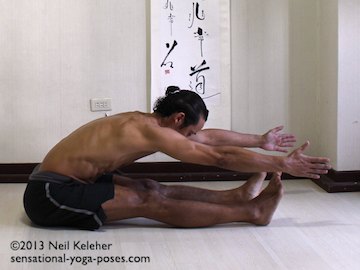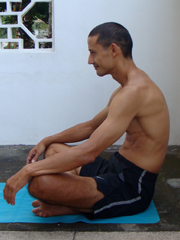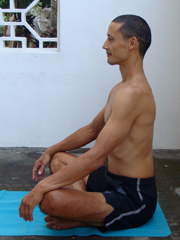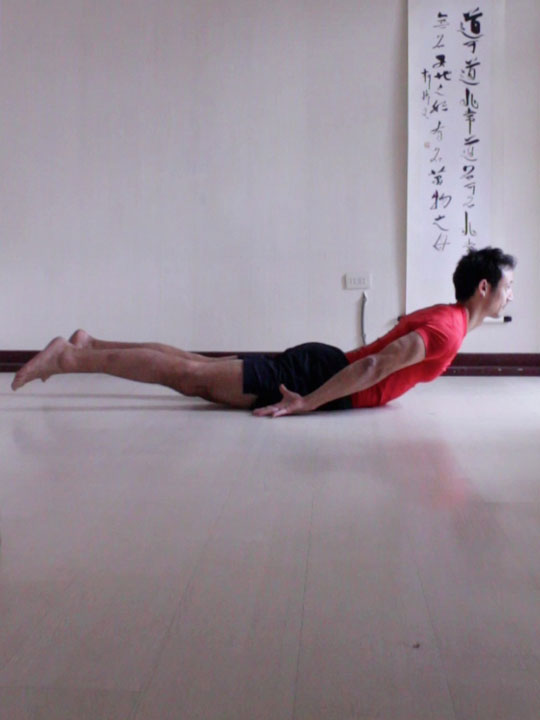Creating a Hunchback-Free Seated Forward Bend
On page cat links

A visitor recently asked me what she could do about hunching her back in seated forward bend (paschimotanasana.) She hunches her back and wants to know how to prevent it.
On page cat links

A visitor recently asked me what she could do about hunching her back in seated forward bend (paschimotanasana.) She hunches her back and wants to know how to prevent it.
First of all, in most hamstring stretching yoga poses the goal can be to tilt your pelvis forwards. If one or both legs is straight while you do this then you stretch the hamstrings of the straight leg(s). If one or both knees are bent then when you tilt your pelvis forwards you are working in some way on opening the back of the hip joint. More specifically you'll be stretching the hip extensors.
Because the hamstrings cross both the back of the knee and the back of the hip joint, the knee generally has to be straight to stretch this muscle.
So then, why is a hunched back bad while doing a seated forward bend?
Well first of all it's not necessarily bad.
It you are deliberately bending your spine forwards to stretch the back of your spine then it's okay.
(And if you have low back pain, it may help to stretch it out.)
If you focus on feeling your body while doing this you can stop if you feel yourself going too far.
However most people tend to do hunch their back or curve their spine forwards because they are unaware. They might think that the goal of a seated forward bend is to get their face, nose or lips to the knees and so in order to do that they bend where its easiest to bend, at the spine.
Generally, people in this condition have tight hamstrings and so their focus can be on tilting the pelvis forwards. If you keep your spine straight you'll have to tilt your pelvis forwards in order to get your chest, face of lips to your knees. Once you have some proficiency at tilting the pelvis forwards while keeping the spine straight then see if you can do the same thing while bending the spine.
With a forward bent lumbar spine you may be giving your psoas major more room to contract so that it is able to help your forward bend.

In this seated forward bend I'm adding weight to the stretch by reaching my hands forwards.
I've got a slight curve in my upper back but not enough to make me hunched.
That being said, if you keep your spine straight you may be able to use the weight of your upper body to help you get deeper into the forward bend. You'll then be using this seated yoga pose to strengthen your back.
If that is the case then the muscles you need to be able to activate are your spinal erectors. These are the muscles that run up the back of your body on either side of the spine. They can be used to bend the spine backwards.
In a seated forward bend, if you can lean at least a little bit forwards then you can use gravity to help pull your upper body forwards (and down) even more. But so that gravity has more leverage, you can use your spinal erectors to stiffen the connection between your pelvis, ribcage and head. By using these muscles to "bend your spine backwards" they actually work against the pull of gravity.
In a seated forward bend, if you are tilted forwards at you hip joints, gravity pulls downwards on your ribcage and head. Meanwhile your spinal erectors, acting from the back of your pelvis and sacrum pull back and up on the ribcage and head.
This is assuming you have some forward tilt. If you haven't then you gravity isn't helping. Instead it is resisting the forward bend.
Anyway because these muscles (the erector spinae as they are also known) are anchored at the pelvis and sacrum, they effectively add the weight of the ribcage and head to the pelvis, helping to tilt the pelvis forwards forwards.
However, the hamstrings, attaching between the sit bones and the bottom of the back of the knee joint resist this pull.
The trick is then getting them to relax so that you can stretch them.
For that you can do a couple of things. You can try to trick your hamstrings into relaxing (or train them to) or you can just add more weight forcing them to lengthen.
But more on that in a moment.
The question was about keeping the chest open in a seated forward bend. Well actually it was about not hunching the back. However, if you lift the front ribs, while at the same time bending the thoracic spine backwards, you'll remove the hunched back.
And to make "not-hunching" easier in a seated forward bend, you can practice not-hunching while just sitting upright.
A very simple exercise is to do spinal back bends and forward bends while sitting upright.


As you curve your spine backwards allow your pelvis to tilt forwards. While curving your spine forwards allow your pelvis to tilt backwards.
Initially focus on bending at your lumbar spine (the part of the spine that joins pelvis to ribcage). Then try to move the action into the thoracic spine. (This is the part of the spinal column that the ribs attach to.) Actively curve your lumbar and thoracic spine backwards and then forwards.
Because the ribs attach to the thoracic spine, what you will find as you bend your thoracic spine backwards is that your front ribs will lift and expand. As you bend it forwards your front ribs will sink and possibly contract inwards a little.
To make bending your spine backwards easier, accentuate the lifting and expanding action of your ribcage. Bending the spine backwards uses the spinal erectors. Expanding and lifting the ribs uses the muscles between the ribs called the intercostals (most likely the external intercostals although the internal intercostals may help.) It may also use the external obliques (and inner obliques.) The more you focus on lifting and expanding your front and side ribs, the more likely you are to be using your intercostals and obliques.
To make back bending your thoracic spine even easier, try to also lift the backs of your ribs. You can think of this action as giving your thoracic spine room to bend backwards. As you inhale and bend backwards focus on lifting your "back ribs" towards the back of your head. Lift the back ribs first and then try to gradually bend backwards while at the same time opening the front and sides of the ribcage.
If you are having trouble, try doing this same action while lifting up into locust pose (shalabasana.)
Now in an actual seated forward bend you probably won't be creating an actual backbend or backwards curve in your spine. However, what is important is learning to feel your spinal erectors, intercostals and even levator costalis activating (Levator costalis are the muscles that lift the backs of the ribs).
If you can feel these muscles while sitting upright (or laying down on your belly in locust, the pose in the picture below) then you can try to create that same feeling while in a forward bend.

Locust Pose
And to make it easier, focus on doing this while inhaling. Actually use this action to help you inhale. Since bending the spine backwards and opening the ribs expands the ribcage then inhales naturally occur when you do this action. So it's a good way to help control your breathing. Bending the spine forwards does the opposite, and reduces the volume of the ribcage.
So, while you are doing a seated forward bend, work at bending your spine backwards while inhaling and let your head and ribcage sink down while exhaling.
Generally I have my students start of doing this exercise while sitting upright with their legs straight ahead. Then I have them gradually tilt their pelvis forwards while continuing to move their spine and ribs with their breath.
So that the focus is more on breathing, and moving the spine (so that it is unhunched at least half of the time) you can use your hands to help support your body. Just place you hands on the floor beside you and lightly press down.
Towards the end of your time in seated forward bend, you can relax the bending back and forth of your spine and simply relax downwards while continuing to keep your chest open. Now, instead of bending your spine to drive your breath, try breathing just by moving your ribs or just by moving your upper belly. If you breathe into your upper belly you can then focus on keeping your chest open and your back un-hunched.
So far I haven't mentioned the head and neck. I'd suggest that whether sitting upright or bending forwards, keep your head and neck in line with your spine.
If anything, while bending your spine backwards pull your head back, but rather than tilting your head back, keep it "level" relative to your ribcage. Focus on pulling the back of your head back and up, away from your ribcage.
Another technique for removing a hunched back while doing a seated forward bend is to focus on feeling the front and back of your ribcage. As you inhale focus on reaching your ribs away from your pelvis. Exhale as you relax. Focus on feeling the front and back of your ribcage (as well as the sides.) As with the previous version of this yoga pose, practice this first while sitting upright. Then once you have the feeling of lifting your ribs away from your pelvis and then relaxing them, try to find the same feeling while bending forwards.
To prevent your back from hunching focus on lengthening your spine and upper body. Reach your ribs and head away from your pelvis. Do this slowly and smoothly each time you inhale. Then slowly and smoothly relax while exhaling.
Use the same head action. As you pull your ribs upwards (away from your pelvis) pull your head back an up (away from your ribcage.) Relax neck and ribcage while exhaling.
If your hamstrings are really tight (like iron or steal that will not bend, even if heated to super high temperature), you'll be reaching upwards more than forwards each time you inhale. If this is the case or hamstrings are so tight that you can't even sit upright with one or both legs straight, then sit on blocks or edge of a sofa or chair (or table) so that you upper body does tilt forwards.
Then as you inhale focus on lengthening your upper body away from your pelvis and as you exhale allow your ribcage and head to sink down.
By practicing daily you may find that you can gradually reduce the height of your prop. (Don't go sawing the legs off of your sofa. Just find something lower to sit on.) As you do reduce the height of your prop, remember the feeling of keeping your spine long and also the feeling of tilting your pelvis forwards. So now, some ideas on actually stretching your hamstrings as you do the seated forward bend.
As I mentioned, one way to use the spinal erectors, particularly while inhaling is to resist gravity so that the weight of your head and ribcage help to tilt your pelvis forwards. Ideally you then can use this weight to help stretch your hamstrings. However, your hamstrings might not want to let go.
It's kind of like snatching your baby off of the bed while its still sleeping. I did that to my daughter once and she woke up in just a little bit of a shock. (Her babysitter knocked on the door to pick her up and so I woke her quickly because I didn't want to keep the baby sitter waiting. I didn't do that again.)
The preferable way is to wake a baby up gently.
Or you gently lift her off of the bed. He or she may even stay relaxed and asleep.
With the hamstrings you may be able to induce them to relax by using your arms to support the weight of your upper body. Use them as braces. If the arms are supporting the weight of the upper body the hamstrings don't have to.
You can then try to relax your hamstrings. (This may take some practice.)
You can then gently relax your arms, let your elbows bend, and at the same time activating the spine erectors and straighten your spine. You then gently add weight to the hamstrings while working to keep them relaxed so that they lengthen. And then when exhaling you use your arms again to support the weight of your upper body.
If you want to add more weight, you can relax your arms, activate your spinal erectors and even your intercostals (open your chest!) and then slowly reach your arms forwards.
You arms have weight to and so by reaching them forwards as far as you can you can gradually add more weight to your body helping to increase the stretch to your hamstrings while doing a seated forward bend. At the same time you keep your spine straight so that you don't have a hunched back. And at the same time you can work at tilting your pelvis forwards.
You can either reach your arms and then lower them in time with your breath or you can try continuously reaching them as you get more used to this exercise.
Now even if you can't willfully relax your hamstrings, you may find that if you move slowly, i.e. gradually reaching your spine and arms forwards while inhaling and then using them to prop your body while you exhale, you may lengthen your hamstrings anyway.
This is kind of a brute force method but if you focus on moving smoothly it may help.
If your hamstrings are stuck what may help is to ratchet them. Well you aren't actually ratcheting them but the idea is similar.
While doing the above exercise, reaching forwards with your arms and spine and then relaxing, you can actively engage your hamstrings and then relax them. Actually you may be engaging more than just your hamstrings. The idea is that by actively engaging them you may find it easier to then relax them afterwards.
If you are using a couch to prop your self up you may want to put something under your knees so that you can press your knees down while doing this exercise!
One suggestion for learning how to do use your legs is to place blocks under your thighs while sitting upright with your legs straight ahead. You can place the blocks just behind your knees (but between the knees and the pelvis.) Usually I try a few different position for the blocks.
As you inhale press your thighs down into the blocks. Your feet will lift. Then relax. While still sitting upright you can reach your arms forwards as you press your thighs down and then relax them as you relax your legs.
See if you can tilt your pelvis forwards a little and then do the same thing, press your thighs down to lift your feet and reach your arms forwards while making your spine long. See if you can reach far enough forwards that your butt comes off of the floor. Then slowly lower.
Remember to lengthen your spine (and straighten it) as you do this. Get rid of the hump?
Once you've got the hang of this, then try to find the same feeling without the blocks.
This time as you inhale press your legs down, engage your spine erectors and reach your arms forwards while lengthening your spine.
Relax your legs and leg your spine bend forwards as you exhale.
As you exhale let your spine round. Let your head and chest sink down… slowly. Then straighten your spine and remove the hump while inhaling.
If you continue to use this technique you can try varying where you push down. Maybe press down at the back of your thighs, or try pressing your heels down. Or try to press your thighs and heels both down as you inhale. In this case you may find that your pelvis tilts forwards even though your hamstrings are active. See if you can relax them while keeping the length when you exhale.
Another action that you can try either by itself or in combination with the above techniques is to focus on lengthening your leg(s). Make them feel long.
This can start with creating space in your hip sockets. By that I mean literally reaching your thigh bones away from the pelvis.
While getting ready to do your seated forward bend, practice reaching the bones of your legs forwards, out of your hip sockets.
Reach through the bones of your feet at the same time, as if pulling on boots.
Then while doing this pull the muscles of your shins and thighs back. Pull back on the front, sides, insides and back of your legs.
It can feel like pulling on a glove or a tight pair of jeans (with boots attached). However, instead of a pair of jeans what you are actually pulling up on is your muscles, or even better, the connective tissue that the muscles of your legs act on.
Generally, wherever there is "slack" in some part of your legs, the idea of activating your leg muscles is to remove this slack.
By doing so you actually create a firm foundation for the muscles that help your seated forward bend. That foundation is provided by your connective tissue.
In particular you may find that adding tension to your inner thighs may help your psoas major. Your psoas can then act from your inner thigh to pull forwards on your lumbar spine.
But at the same time, inline with removing the hunch from your back, you can also lengthen and add tension to both the front and back of your upper body.
And getting back to the legs, you can also try adding tension to the fronts of your thighs
You may also find it helpful to add tension to the sides of the thighs, using this tension to spread and open the buttocks. (This is usually easier in standing forward bends. However if you wiggle from side to side you may give yourself room to do this while doing the seated forward bend.)
Something else to be aware of when doing seated forward bends. As you bend forwards your heels may resist and actually act to compress your legs and hip socket. So work at pushing your heels away from you as you bend forwards.
In addition, to further add tension to your connective tissue (in a way that is helpful to your seated forward bend) reach your toes upwards, out of your feet. Imagine that you are trying to straighten and stretch your toes and continually try to stretch them. Imagine you are pulling gloves onto your toes and your toes are trying to pierce them.
Are these techniques limited to just paschimottanasana?
Actually not. You can try them in any seated forward bend.
With the goal of preventing back hunching, position your legs according to the yoga pose that you are doing and first practice bending your spine backwards and forwards or practice reaching your ribs and head away from your pelvis. And either lengthen your leg(s) or press them down (or do both.)
Then continue doing these actions as you bend forwards.
In wide leg seated front bend, the instructions can be almost exactly the same.
Actually, I often like to do this seated forward bend before paschimottanasana because it is a little bit of an easier hamstring stretch.
The only challenge in this pose relative to paschimottanasana is that you may have to work to keep your knees pointing upwards. They can tend to roll inwards in this yoga pose.
In janu sirsasana a, janu sirsasana b and janu sirsasana c you can try reaching your straight leg forwards or try pressing it down into the floor. Or see if you can do both. In janu sirsasana a and b I'd suggest trying to reach just the thigh of the bent knee away from the hip. You may also find that you can make your shin feel long. Another option to make the bent leg alive is to press your foot into he floor. In the B version of this pose try pressing your bottom shin into the floor.
In the C variation of this pose, press your bent leg heel into your inner thigh. You can try to get a feeling like you are trying to stand on the ball of your bent knee foot. At the same time reach your knee down into the floor, away from your hip joint. Because your heel is up in this posture, you may find that you bend your spine forwards a little to accommodate this.
In triang muka eka pada paschimottanasana, (half hero forward bend) try reaching both thighs forwards (both bent knee and straight knee.) If you find yourself leaning towards the straight leg side in this seated forward bend, try pressing down with the heel and thigh of your straight leg. But, try reaching the leg forwards at the same time.
In half bound lotus (ardha badda padma paschimottanasana) try squeezing your leg at the knee joint as if trying to squeeze the knee shut. At the same time press your lotus foot down onto your thigh. Keep the foot active so that it is easier to grab and keep a hold of.
Again, in all of these poses, even as you stretch your hamstrings, work at making your spine long and ribcage open to prevent your back from hunching.
Once you've found the feeling, try to keep it and then work at breathing into your upper belly and lower side ribcage.
(Here's the video.)
